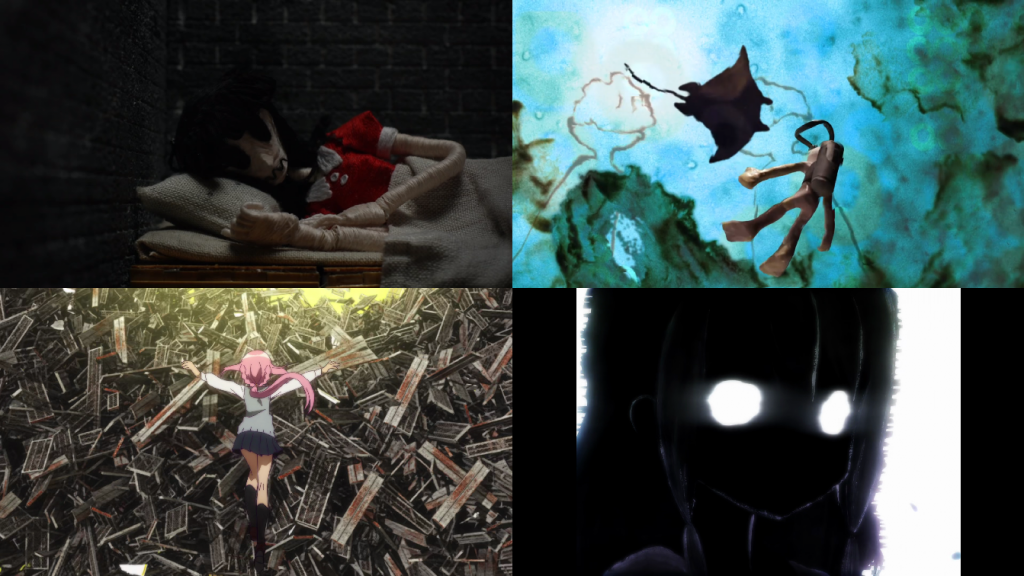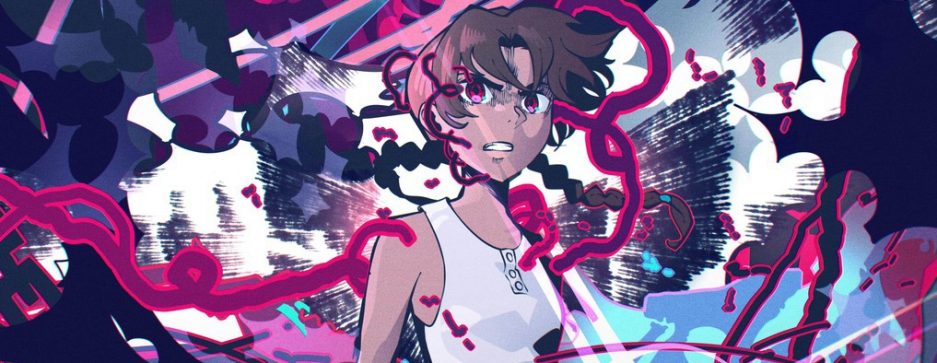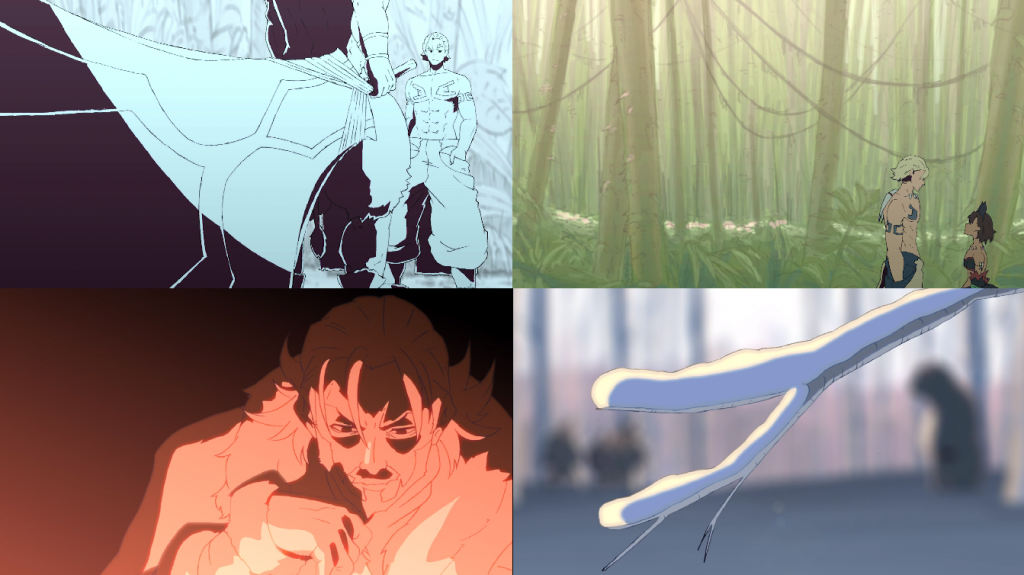As a preface: this is by no means a rebuttal against the “Shaft is Dead” rhetoric getting thrown around recently. Is it lacking in nuance and not entirely accurate? Sure, but when one of their most important directors is making jokes like “how has this company not gone under yet,” it’d be crazy to spend all my time arguing over exactly how bad things are. Besides, the fact that things are so bad at my favorite studio is the key to something far more interesting: a generational shift. A shift in the wake of its recent high profile departures is as harsh as it is promising. Today however, we focus on the promise.
Naoaki Shibuta (渋田直彰)

His GeiDai graduation work, Shoujo no Ito, Mahou no Ito – Better Back Then, is delightfully wicked. In it, a girl locked up with a cruel witch for whom she performs menial labor finally decides to do away with the old hag. Our protagonist’s attempts to kill her become drastically more desperate and absurd until she eventually gets what she wants, only to stop herself in the end, afraid of breaking the cycle she now can’t live without. The ending stinger reveals that she has the same abilities as the witch, and the same potential to carry on her corrupt legacy.
Stop-motion is tailor-made for easy surface level horror: the jittery motions, the unavoidable imperfections, and the lack of expressiveness is enough to get under people’s skins even if the material alone is not. Better Back Then feels like a nice mix of both: a simple yet grizzly tale accentuated by the off-kilter nature of stop-mo. It makes for some fun comedy too: a literal stab in the back portrayed and animated in the most nonchalant way to sell the futility of it all.
Better Back Then is a fun and unsettling romp, but his first year project was the one that really won me over. Come Back to My Mind brought back those bittersweet memories of being a kid, and the envy that came with seeing another friend hang out with someone else. The feeling of a connection lost – the distance between you and your friend slowly growing further and further, to the point where it feels like you’re in a far off galaxy or 20,000 leagues under the sea – is portrayed through an eclectic mish-mash of different styles and scenarios. Still though, the ending is a nice reminder that we shouldn’t let our envy hold us back from meeting new people, and who knows? You might get along with them in your own weird way more than you might think.
Shibuta’s been at the studio for a quite a while. He started out as an inbetweener in 2011, and for the most part…that’s all he’s been doing. It wasn’t until just last year that he was credited with Otherworldly Space Design alongside Inu Curry on Magia Record – a huge leap that finally made good use of his stop-mo background, albeit still under less than ideal circumstances – another sign of the studio’s aforementioned violent generational shift. It’s true that the industry isn’t very compatible with those roles to begin with, but it really is a crime to sit on talent this long without utilizing it for the more striking moments in a show. He made his debut as an assistant episode director on Assault Lily #11, and if the trend continues, a genuine debut could be in the cards for Bishounen Tanteidan as well!
Hiroto Nagata (長田寛人) Kazuki Kawada (川田和樹)

This duo suddenly rising from the ashes was an honest-to-god surprise to everyone, even the most seasoned of Shaft fans. They were quietly doing douga for a few years on projects like Zaregoto and the Kizumonogatari films, but Nagata’s student work was already a promising sign of things to come.
T’s Room captures that early morning mad-dash to get yourself together with dense water effects that don’t let up and surprisingly lavish mechanical design. Both are elements Nagata already had a strong grasp on, and pushed it even further once he started doing Key Animation at the studio. His work on Assault Lily #8 turned heads for a damn good reason. It’s the type of high-octane action that grabs you by the throat and doesn’t dare let go. It’s not just fights either, Nagata’s always elevating small moments into something much more for the viewers.
Not to completely throw Kawada under the bus either. Assault Lily #5 features some cute low-key acting from him. I love how the hair still tapers apart after the turn around, it’s a lovely little detail that ties back into elevating the mundane. Both animators function as the studio’s effect specialists at the moment, but it’d be a shame to see them pigeonholed into just action. Especially for Kawada, as he’s gotten a few more moments to show off his adorable character acting as well.
Ryo Shimura (志村亮)
I really do think Shimura’s the most exciting young talent at the studio at the moment. He’s still in the training phase – he only started with inbetweens on MagiReco last year – but I hold his student work in ridiculously high regard for it’s sheer ambition alone.
Neither of his works – Inherit or Nue – are the most technically sound or well realized, and that’s because…they’re student films. Watching both of his shorts were a weird sort of wake-up call for me. I’m used to seeing the most lavish and well-made of the bunch getting the most attention, and as a result, I forgot just how appealing the rawness of pure unfettered ambition could be. Inherit is a shining star in that regard. It’d be easy, and frankly redundant, to point out all its flaws, but Shimura’s ambition is still heads and shoulders over those complaints. I love these grand and spacious layouts. Besides being well-staged and appealing to the eye, they sell the grandeur of these obscenely detailed designs which are totally inappropriate for a one-man student project. Any short can end things off with a simple fight, but Shimura’s daring enough to close things out with a 1 vs 100-man battle! It’s the kind of climax that gets your blood pumping even if the animation can’t fully keep up with it.
There are even bigger shake-ups going on that I haven’t even fully touched on yet. Comfortable regulars like Midori Yoshizawa and Hajime Otani now functioning as important pillars for the studio and the sudden appearance of Shaft’s in-house CG team. The generational shift is legitimately interesting to keep up with and is worth talking about, I just wish it was under more ideal circumstances for the sake of the artists as well.


One thought on “What Ever Happened? (…To Studio Shaft.)”